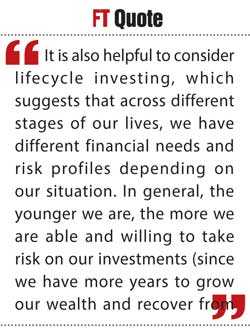Friday Apr 04, 2025
Friday Apr 04, 2025
Friday, 19 October 2018 00:00 - - {{hitsCtrl.values.hits}}


In our childhood, we learn some life skills which we never really forget - skills such as riding a bicycle or swimming. But how often do we learn at a young age how to save and invest and plan our finances for ourselves and our loved ones? Yet certain financial skills, such as making investment decisions, impact our longer-term life choices.
Starting to invest early is probably one of the basics of financial knowledge one needs at an early age. This is because the longer one lets one’s money grow, the bigger it grows. As Albert Einstein famously said: “Compound interest is the eighth wonder of the world and the most powerful force in the universe.”
Once we start early, the next crucial investment idea is the knowledge that capital preservation is key to generating sustainable long-term returns. Yet, knowingly or unknowingly, many of us still find ourselves trying to “time the market” and sometimes “picking up coins in front of a proverbial steamroller”, at the cost of ignoring the massive risks that could come to pass. Part of the reason is the FOMO (fear of missing out) factor.
Some of us also have the tendency to cash out too early, or panic and sell during market drawdowns. Doing so, we run the risk of not being invested in markets, thus missing strong market rebounds as and when they happen.
As an illustration, for a hypothetical investment in the US S&P500 total return stock index from 1993 to 2018, we analysed the impact of missing out of the 25 best performing days. We found that although the S&P500 returned an average 9.8% annually over the 25-year period, by just missing the 25 best performing days, the overall performance would have dropped to just 3.9% annually. How confident are we of perfectly timing the market over the longer term?
This is why we believe “boring is beautiful” in the world of investing. For a moderate risk investment portfolio, staying invested for the longer term and targeting annual returns of 4-6% - oftentimes thought of as “boring”, especially within the racy world of chasing double-digit returns - can be the best strategy to offset any temporary drawdowns in one’s portfolio. It is important to remember that a 50% portfolio loss (suffered from pursuing an aggressive investment strategy) would need a 100% portfolio gain to get back to where we started!
‘The only free lunch in finance’
Besides compounding and long-term investing, the other core financial idea is ‘diversification’. Nobel prize-winning economist Harry Markowitz, credited with modern portfolio theory, described diversification as “the only free lunch in finance”. It’s the concept of not ‘putting all your eggs in the same basket’ but spreading the risk across different asset classes. This idea has two major goals: i) to help increase the expected return on investments, while taking less risk and ii) to avoid large losses.
To illustrate this, we compared two portfolios, one allocated purely in equities and the other holding an equal (50/50) split between bonds and equities from 1990 to 2018. We found that while the average annual returns were slightly lower for the 50/50 balanced portfolio (+8.4%), as compared with the 100% equity portfolio (+9.4%), the balanced portfolio was far less risky, with much lower annual volatility (9.3%) as compared with the equity portfolio (17.5%).
In addition, the 50/50 balanced portfolio also preserved capital far more effectively, as its maximum drawdown (-26.5%) was considerably less than the equity portfolio (-45.8%). This highlights the value of diversifying across asset classes.
Hence, as a guide, a balanced portfolio will generally have some mix of equities, bonds, alternative assets and cash. The right balance depends on one’s return goals, appetite for risk and liquidity needs. It is good discipline to rebalance the portfolio once or twice a year so that it stays diversified over time and various allocation weights do not drift from the desired allocation.
It is also helpful to consider lifecycle investing, which suggests that across different stages of our lives, we have different financial needs and risk profiles depending on our situation. In general, the younger we are, the more we are able and willing to take risk on our investments (since we have more years to grow our wealth and recover from drawdowns). As we move through different stages of our life, our financial needs and circumstances often change. Our allocation to risky vs. non-risky assets will change as a result to best fit our needs.
Finally, we should be realistic with our return expectations and the risk that goes along with it, given the changing economic landscape and long-term structural pressures on growth and inflation. One way to gauge this is to look at historical investment returns and compare them with forward-looking expectations. As an example, US equities delivered annual average returns of 9.1% from 1993-2017, with annual volatility of 14.5%, while forward-looking expectations, according to studies done by Mercer Consulting, see almost half those annual returns (4.9%) over the next seven years and increased volatility of 18%.
Similarly, Emerging Market debt, which historically has delivered annual returns of 9.4%, with volatility of 11.8%, is expected to only deliver 4.1% annual average returns, with volatility of 9.0% over the next seven years.
In summary, the fundamentals of investing relies on a few core principles such as starting as early as possible, staying put for the long-term and applying a well-crafted and disciplined roadmap based on diversification, regular portfolio rebalancing and tailoring our allocations to our lifecycle needs. Internalising these guidelines should lay a strong foundation for one’s financial future. Ultimately, managing our investment portfolio is similar to learning to ride a bicycle - once we learn, we’ll never forget!
(The writer is Head of Portfolio Strategy at Standard Chartered Private Bank)
Discover Kapruka, the leading online shopping platform in Sri Lanka, where you can conveniently send Gifts and Flowers to your loved ones for any event including Valentine ’s Day. Explore a wide range of popular Shopping Categories on Kapruka, including Toys, Groceries, Electronics, Birthday Cakes, Fruits, Chocolates, Flower Bouquets, Clothing, Watches, Lingerie, Gift Sets and Jewellery. Also if you’re interested in selling with Kapruka, Partner Central by Kapruka is the best solution to start with. Moreover, through Kapruka Global Shop, you can also enjoy the convenience of purchasing products from renowned platforms like Amazon and eBay and have them delivered to Sri Lanka.
Discover Kapruka, the leading online shopping platform in Sri Lanka, where you can conveniently send Gifts and Flowers to your loved ones for any event including Valentine ’s Day. Explore a wide range of popular Shopping Categories on Kapruka, including Toys, Groceries, Electronics, Birthday Cakes, Fruits, Chocolates, Flower Bouquets, Clothing, Watches, Lingerie, Gift Sets and Jewellery. Also if you’re interested in selling with Kapruka, Partner Central by Kapruka is the best solution to start with. Moreover, through Kapruka Global Shop, you can also enjoy the convenience of purchasing products from renowned platforms like Amazon and eBay and have them delivered to Sri Lanka.